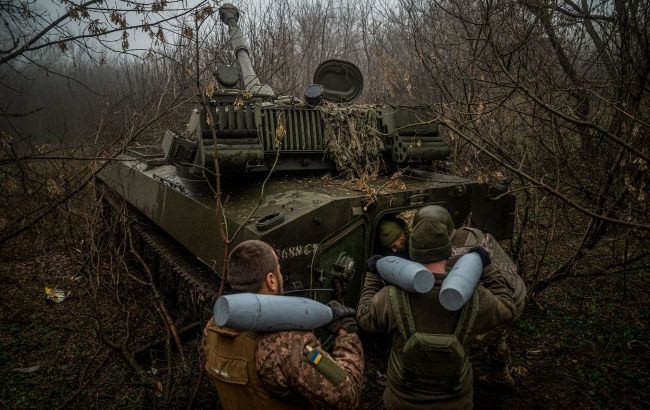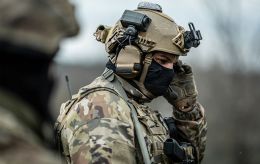Foothold on Dnieper left bank, Avdiivka and other hotspots: What's the situation at front?
 The Ukrainian Armed Forces continue operations on the left bank of the Dnieper, while the Russians want to surround Avdiivka (Photo: Getty Images)
The Ukrainian Armed Forces continue operations on the left bank of the Dnieper, while the Russians want to surround Avdiivka (Photo: Getty Images)
Ukrainian soldiers on the left bank of the Kherson region are expanding their foothold, presenting the enemy with a dilemma. Meanwhile, occupiers are continuously assaulting our positions on the eastern front, attempting to encircle Avdiivka and advance in the Bakhmut direction.
Military expert Vladyslav Seleznov commented to RBC-Ukraine on the situation on the front and the factors influencing the developments.
Left bank of the Kherson region
On the left bank of Kherson, there is still a certain fog of war. Official spokespeople recommend cautious commentary on what is happening there. However, it is no longer a secret that Ukrainian marines maintain at least three footholds on the left bank: near the Antonivskyi road bridge and railway bridge, as well as the settlement of Krynka. The distance along the flanks of these three footholds is approximately 60 kilometers.
The number of enemy forces concentrated south of Kherson is about 65,000. The enemy actively uses all these forces to block the advancement of Ukrainian troops. Fierce battles are occurring near the settlements of Krynka, Pidstepne, and Pischanivka.
Our troops' key problem is the lack of stable logistics for the operational transfer of weapons, ammunition, and armored vehicles from the right to the left bank. The distance between the banks of the Dnieper in this part is a thousand meters. The enemy has destroyed four bridge crossings and the Kakhovka Hydroelectric Station. In other words, there are no permanent engineering structures across the Dnipro – a pontoon bridge needs to be set up, which is highly challenging.
An even more challenging task is to protect this pontoon bridge from destruction by the enemy. To achieve this, western interceptors are needed to keep enemy aviation as far away as possible and expand our foothold on the left bank to push back enemy artillery. The situation is somewhat controlled while battles are taking place near the Dnipro. Our artillery from the right bank supports our marines on the left bank. They are partly under the umbrella of our air defense systems on the right bank. However, they will increasingly move out of this coverage zone if they advance further.
The enemy perceives our actions quite nervously. Firstly, it is indicative that the occupation forces in Kherson are now commanded by Mykhailo Teplynsky, arguably the most professional general in the Russian army. Having 65,000 personnel, the enemy uses them cautiously - they do not throw all their people into battle at once but act with a limited contingent.
Secondly, recently, the Russians transferred four airborne assault divisions to the Tokmak area. Currently, units of one of them - the 7th - have been directed to Kherson. Perhaps the enemy understands that it is necessary to rapidly reinforce its troops with units that can move to designated positions to counter the Ukrainian counteroffensive more actively.
Moreover, a road runs along the Dnieper from Oleshky to Krynka. It is strategic and crucial for the operational movement of resources. This road is cut at least in two places by our marines. Thus, the occupiers need to use alternative logistic routes, increasing the time and leading to delays in reaction.
Avdiivka Direction
The enemy is trying to close the trap, encircling our units in Avdiivka. The situation in this area is very dynamic. The enemy has concentrated up to 40,000 personnel there and is trying to transform them into territorial gains, disregarding losses.
One of the key points where the enemy is making incredible efforts to change the situation on the Avdiivka front is the Maryinka area. On certain days, a third of enemy combat clashes occur precisely on the Maryinka front. The occupiers seek to create a so-called buffer zone around Donetsk. Although battles have been ongoing in the Maryinka area for 20 consecutive months, our military still controls the western part of the city.
Bakhmut Direction
Fierce combat is ongoing in the Berkhivka and Yahidne areas. The Russian army retains the capability to advance. This forces our troops to retreat several hundred meters to different lines and positions in some sections. The enemy seeks to secure its garrison operating in the ruins of Bakhmut.
South of Bakhmut, the Ukrainian army maintains the initiative; our forces attempt to advance in the Klishchiivka and Andriivka areas. However, the enemy consistently launches counterattacks there to slow down our movement.
Kupiansk-Lyman foothold
In the Kupiansk area, the enemy started creeping along the railway line. Kupyansk is a huge junction railway center, so the enemy wants to capture at least its eastern part, where various railway tracks and connections are located. A more ambitious desire of the enemy is to align the front lines along the Oskil River. The trend is that the enemy has the initiative on this front segment.
On the Lyman front, battles are taking place in the Serebrianske forestry. However, calling it forestry is tricky, as the land there has practically become scorched after months of fighting.
Azov Sea region
On the Berdiansk front, in the Staromykhailivka area, the situation has stabilized, and the intensity of battles there is somewhat lower. As for the Tokmak or Melitopol direction, the situation is more dynamic. Defensive forces continue to attack directly on the Suvorovikin defensive structures line. There are small-scale advancements. The initiative remains on our side. However, our progress is plodding due to a robust network of fortifications and anti-infantry and anti-tank fields. The outcome of the fall-winter campaign in this direction depends on the resources of the Ukrainian army.

